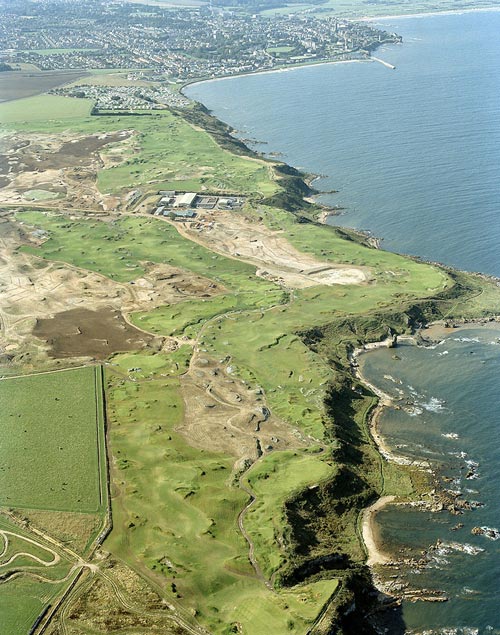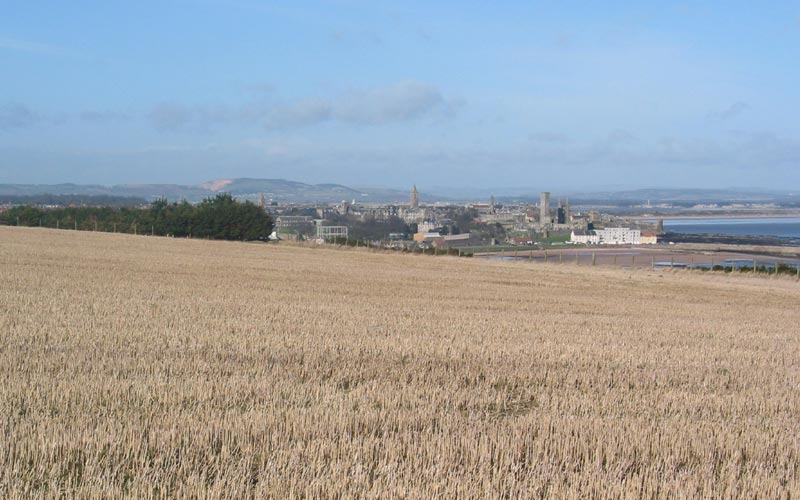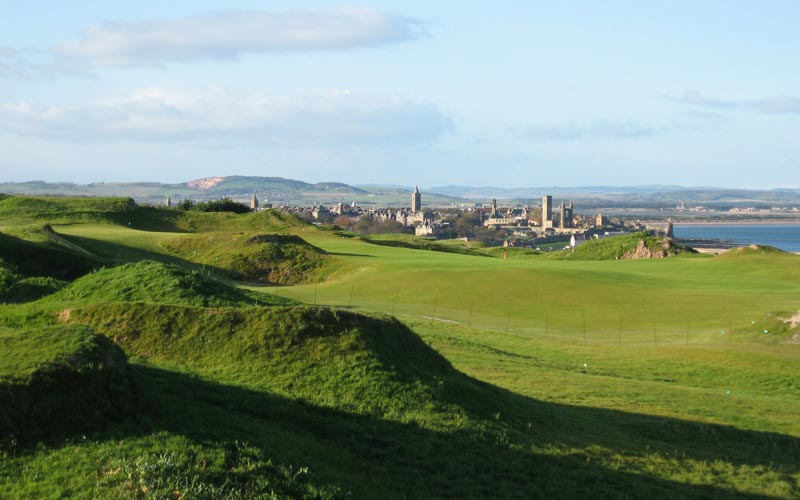Feature Interview with Scott Gummer
October, 2007
Scott Gummer has contributed to overforty magazines, including Sports Illustrated, LIFE, Fortune, Men’s Journal, Robb Report, Vanity Fair, T+L Golf, Golf Digest, and GOLF, where he was a Senior Writer. He also ghostwrote portions of comedian George Lopez’s New York Times bestseller “Why You Crying?” Gummer lives in the Northern California wine country and can be reachedat scottgummer@yahoo.com
What were the driving factors in the St. Andrews Links Trust deciding to pursue its first public championship course since 1914?
That depends on whom you ask! Critics of a seventh course seemed less opposed to the actual golf course and more at odds with the Links Trust, accusing the brass of empire building and endeavoring to shoo the locals up to the seventh course so as to free up the Old Course for rich tourists forking over big-ticket green fees. Those accusations were shortsighted. In truth, Alan McGregor and his staff at the Links Trust are a well-intentioned group. I spent a fair amount of time inside Pilmour House, their headquarters, talking to staff and burrowing through research, and the Trust exists in a no-win situation given the fact that they serve multiple, mutually exclusive constituencies—residents, university students, the local golf clubs, and the rest of the golfing world. Plain and simple, the reason for pursuing a seventh course was to ease capacity. The number of rounds across the six courses had reached a breaking point, and the only real options were to either limit demand or increase capacity. Restricting access to annual tickets or jacking up green fees and pricing out a portion of the less affluent golfing public would limit demand, but the Trust’s objective was to accommodate golfers who want to play, not force them to quit. Increasing capacity could be achieved by opening earlier and closing later and/or allowing play on the Old Course on Sunday, however the former would exacerbate wear and tear, and the latter promised to exceed the threshold of 45,000 annual rounds on the Old Course. Ultimately, the Trust looked forward by looking back: a century before, overcrowding on the links led to the building of the New, the Jubilee, and the Eden courses, all in a span of less than 20 years. The Eden, opened in 1914, was the last championship course built by and for the town before the Castle.
When it came time for the Links Trust to select an architect, who was on the short list and why was Kidd ultimately selected?
Sixteen candidates were invited to submit an ersatz Why Me letter. Among the well-known names on the list were Kyle Phillips, Gary Player, and Nick Faldo. Jack Nicklaus was not a candidate, in part because the Links Trust figured they could not afford his fee, but more so because they were set on selecting a hands-on architect. Of the 16 candidates, six were invited to present. The process is detailed in the book, and the list is rather surprising, but in the end David Kidd won the commission base on passion, vision, commitment, and the unique offer to serve not only as architect but also as general contractor.
What is your relationship with David McLay Kidd and how did you get such unfettered access to the entire construction process?
I asked nicely. David Kidd and I met by curious coincidence—the story is in the Preface of the book—and I believe the reason I was able to get exclusive access to the DMK team and unprecedented cooperation from the Links Trust is because I was sincere about aiming to write a fair, honest, and impartial chronicle of the adventure.
Where is the Castle Course at St. Andrews located relative to the town? Please describe the 250 acres with which Kidd was given to work.
The Castle Course is on the east side of town on the way out toward Kingsbarns, between the caravan park and the Fairmont St. Andrews Bay resort. The site was nothing to behold: a flat, brown, derelict potato field devoid of flora, in the middle of which sat the sparkling new St. Andrews sewage treatment plant. “Once you step back from the braes, we haven’t got crap,” Kidd told his deputy, Paul Kimber. “Actually, that’s all we’ve got.”

An aerial view with St. Andrews in the distance.
What were the pros and cons to the property according to Kidd after his first visit?
On the flight from St. Andrews back to the Big Island of Hawaii, where Kidd was building Nanea, he noted the pros and cons on a cocktail napkin: + in St. Andrews on the water – no landforms no character no vegetation bloody walking path below the braes routing challenges the town shitter
What was the budget for building the course? How did it influence the construction process?
Two-and-a-half million pounds sterling, plenty enough to build a golf course but not half enough to create the golf course Kidd envisioned. For that amount, Kidd joked, the trustees might as well have given him the same wheelbarrow, spade, and shovel that the R&A gave Old Tom when he was made keeper of the green. The budget, or lack thereof, was a key reason DMK proposed serving as the general contractor. They were going to break even on the design fee but could earn at least a reasonable profit on the construction. By managing all the sub-contractors DMK could control the entire construction budget, spending strategically and making sure resources were dedicated based on their wants rather than the needs of a contractor more interested in making a buck than a killer golf course.
Please elaborate on your point that ‘The fact that No. 7 was built on dirt as opposed to sand was a good thing in that it largely spared Kidd the inevitable comparisons of his seaside course to the town’s existing links layouts.’
The seventh course is not a links course, nor could it have been given what DMK was (not) given to work with. That freed the team to design a golf course that fit the land as opposed to one that fit a mold. There is an understandable expectation that this newest addition to the portfolio is like the other six, but the Castle is removed from the links not just physically but also metaphysically.
Describe the biggest hurdles in the routing process.
The Castle Course boasts 1.1 miles of dramatic coastline, and the biggest routing hurdle was maximizing the golfer’s experience on the water. As it worked out, every hole offers a water view, and the 6th green, 7th, 8th, and 9th holes, 16th green, and 17th and 18th holes play hard along the cliffs. DMK was able to achieve this routing by convincing the Links Trust to buy two key pieces of land: an acre in front of the wastewater treatment works that now serves as a pathway between the 8th green and the 9th tees, and another five acres in the northeast corner, which allowed the 16th green to overlook the water and the 17th hole to span a chasm that promises to be one of the most exciting par-3s in all golf. That, and fashioning a suitable route for the cattle to cross the course from the neighbor’s farm to grazing grounds along the braes.
Describe the roles of the key members of DMK Golf Design.
Paul Kimber, Kidd’s second-in-command, ran the operation onsite and contributed invaluable, truly brilliant design decisions. The lead shaper, Mick McShane, who also shaped Kingsbarns, was a “Da Vinci with the dozer,” and his protégé Conor Walsh proved to be an indispensable talent manning the digger. They, along with Kidd, are the four main characters, however one of my favorite things in the book is a list of all the people who had a hand in unearthing the Castle. There is an analogy that runs through the book that likens Kidd, Kimber, McShane and Walsh to a band. Likening the DMK lads to the Rolling Stones, Kimber is Keith Richards, an underappreciated genius; McShane is Charlie Watts, the heartbeat of the group; Walsh is Ronnie Wood, all smiles and oozing talent; and Kidd is Mick Jagger, The Man. The players never get the spotlight—or the scrutiny—that the front man gets, but he couldn’t do it without them.

The DMK team, dressed to impress: Paul Kimber, Mick McShane, Conor Walsh, & David McLay Kidd.
A D6 Caterpillar bulldozer was deemed inadequate for the job and Kidd opted for the new D5N “ why? Kidd ponied up for a new dozer and a new digger. He envisioned the seventh course replete with tight, gnarly hummocks and hillocks, but the industry standard D6, weighing 20 tons and sporting a 13-foot wide blade, was too cumbersome and heavy—a cleaver compared to the paring knife Kidd sought. He asked McShane to describe his dream rig. “The new D5N, with an 11-foot blade, low ground pressure, auto-shift and auto-kickdown, fingertip controls for gears and steering, and the air suspension seat,” replied McShane, “and a kick-ass stereo.” When it came to creating the ragged, jagged, saw-toothed look for the bunkers, a dozer would not do so Kidd bought a digger. “Not just any digger,” as I wrote in the book, “but a six-figure, top of the line Caterpillar 312CL hydraulic excavator with a turbo-charged engine, adjustable pilot-operated joysticks, and a 6-foot knuckle bucket that works like a cupped hand with sharp fingernails. The digger can stretch and dip and flick and flit about effortlessly, versus a dozer that treads as gingerly as a size-14 ski boot.”
Two hundred years of farming had stripped the land of its subtlety thus putting pressure on Kidd to manufacture shapes that appear natural. How did he succeed?
By designing holes in 3-D instead of 2-D. Most golf architects design on paper or a computer, but working in two dimensions eliminates the critical element of depth. The edges of a piece of paper or a computer screen become creative boundaries that, when reached, force the designer to stop and start anew. Working on paper or computers is like painting, whereas Kidd and his team sculpted in three-dimensional dirt. In the site office there was a sandbox, two feet wide by three feet long by four inches deep, in which the team would play with ideas. The designers would fiddle with 3-D ideas in the sand that the shapers would then form in the dirt. “Create me the kind of landscape Old Tom might have had,” Kidd told McShane. He implored his shaper to right the wrongs caused by centuries of cattle grazing and potato farming. “They killed the character of the place and buried it. You need to exhume it. Then we can go find ourselves a golf course.”
What is a particular example that turned outso well?
The third hole is a brilliant example. The “before” and “after” photos are in the book. The land in the “before” picture appears to be nice and flat like a neatly made bedspread, whereas the “after” shot looks like it was taken right after a raucous romp in the sack.

The third hole before…

…and after!
Murphy and his Law have a way of showing up on golf course projects. How did he do so during the building of the seventh course?
Let me count the ways. Early on it was the opposition from unexpected corners, like the local tour operators and bed & breakfast association, whose livelihoods are tied to tourism. During the build it was the weather. Biblical rains pounded St. Andrews in the first months of construction, 155% above normal. Murphy’s Law was probably also at play when Conor Walsh missed two weeks due to injury after hurting his back while lifting his golf clubs from the boot of his car.
By the end of its first playing season in 2008, what do you think will be viewed as the most controversial feature on the course?
The thing that is going to generate the most buzz/grousing is the playability of the course. It is no walk in the park. A good round at the Castle is going to feel like a great round. Kidd and his team are staunch defenders of par and big believers in local knowledge; they aim to punish hubris, and they want whiny golfers to think twice about taking a different club—or better yet a caddie—the next time around.
There is a quote in the book that speaks to this:
First class holes…at first sight
excite the most violent spirit of antagonism…
only after the holes have been played many times…
the feeling of resentment disappears.
Alister Mackenzie
The Spirit of St. Andrews
Please describe the fourteenth green.
Nefarious. I joked with Kidd that if the course did not fly with golfers they could blanket it with cement and make one helluva skate park, and the fourteenth green is a prime example. Getting approach shots close to the foreseeable pin placements will require a deft touch, courageous imagination, and blind faith.
Many a match will turn here. As noted in the book, “it would be an unmitigated disaster if all 18 greens were schizoid, but Kidd had no problem with having one putting green late in the game that is wickedly unpredictable.”
What is your favorite hole on the course? What do you like so much about it?
My favorite is the twelfth hole; David and I were walking it in the dirt when he stopped, handed me a paint can, and invited me to design the left fairway bunker. If not for that, I would have a hard time singling out a favorite. The holes that play hard along the braes are all just mind-blowing.
Describe the double green of the ninth and eighteenth and its location.
The only double green on the course, it occupies the plot where once rose Kinkell Castle (thus the inspiration for the name of the course). Kidd and Kimber instantly recognized the need to make this dramatic convergence the focal point of the course, and the entire routing essentially worked its way backwards from there. It sounds like a cop-out, but no words can do this chosen spot justice. “Magical” comes close.
Sprinkled throughout the book are hole-by-hole commentaries by David Kidd, who wrote, “It is our sincere hope that you walk off Kinkell Point feeling satisfied, invigorated, and anxious to go round again.”
Well played.
You have said this is not a golf book. How so?
At its heart, this is a process story. The same book could be written about the making of a vintage of wine or the staging of a Broadway play, mine just happens to be set in the realm of golf. The book has been compared (very generously) to the seminal work in this genre, The Soul of a New Machine by Tracy Kidder. I am thrilled that golfers are having such a positive reaction to the work, though I do hope that non-golfers who enjoy a good yarn and the process story genre will find the book…most notably Oprah, the patron saint of authors, with whom I share a golf teacher.
Signed copies of The Seventh at St. Andrews are available on www.7thCourse.com
The End








